Technology
In 2016, we profiled a then-24-year-old named Jeremy Fiance who had managed to pool together $6 million for a fund focused on his alma mater, UC Berkeley, where as a student he&d brought to campus Kairos Society, an organization for budding entrepreneurs, as well as created a student accelerator called Free Ventures.
Fiance wasn&t waiting on someone to give him a job in venture; he wanted to create his own vehicle — dubbed The House Fund — with the support of the school to invest in its talented students, alums and professors, and eventually channel some of its gains back into the university system. To his mind, regional VCs were too focused on Stanford, creating a funding vacuum — and an opportunity. Why not address it himself?
Fast-forward two years and itapparent that investors give Fiance high marks. To wit, The House Fund is today announcing a second fund with $44 million in capital commitments, including backing from University of California (which oversees a $126 billion endowment) and the Berkeley Endowment Management Company, which provides stewardship of endowment gifts given expressly to UC Berkeley. Other investors include funds of funds, including Ahoy Capital; unnamed family offices; Berkeley alums; and tech execs.
The specific pitch these investors are buying ties partly to the schoolsize, says Fiance. UC Berkeley has 500,000 alums in the world and another 60,000 students on campus. Some of those graduates have also built some very valuable, still-private companies, including Flexport, Nextdoor, Warby Parker, Databricks and DoorDash (all are so-called &unicorn& companies). Others have taken their companies public (think Redfin, Coupa and Cloudera, among others). Naturally, some percentage of UC Berkeley alums have also sold their companies, including Caviar, which was acquired bySquare (and then by DoorDash), and PillPack, which sold to Amazon.
Investors are also betting on Fiancedeveloping track record. Though The House Funddebut vehicle was relatively small, it managed to get checks into the logistics firm Flexport, the email service Superhuman, the teen app Tbh (acquired by Facebook) and Dyndrite, a maker of additive manufacturing software that we first encountered back in April. The House Fundsecond fund already holds some promising stakes, too. Among its bets so far is the blockchain gaming company Forte, founded by esports veteran Kevin Chou, who previously founded (and sold) Kabam; Oasis Labs, a cryptographic project whose founder previously sold an earlier startup, Ensighta, to FireEye; and Placement.com, a seven-month-old company that aims to help people find better jobs in new cities. (Its co-founders, Sean Linehan and Katie Kent, came out of Flexport.)
Most of all, perhaps, they&re counting on Fianceability to continue growing a network that has already allowed The House Fund to meet with more than 3,000 startups with ties to UC Berkeley. (It has funded 50 in total.)
He has help. Though The House Fund remains a capital pool with just one general partner, Fiance is quick to acknowledge the team he has built. Among these members is Cameron Baradar, who was the third engineer at the mapping visualization startup Mapsense before it was acquired by Apple and who is now a partner at the firm; Brett Wilson, who founded the ad tech startup TubeMogul and sold it to Adobe in 2017 and is a venture partner; Annie Tsai, a former CMO at the marketing automation company Demandforce who is a part-time partner; and Arjun Arora, who founded and sold an ad tech startup, worked as an investor for both Expa and 500 Startups, and is now also a part-time partner.
As for the size checks the team is writing, Fiance says the firm &sized the fund in such a way that we were right-sizing to the opportunity in front of us.& What that means: while The House Fund once wrote checks of $50,000 to $100,000, itnow investing up to $1 million in seed rounds, with an undisclosed amount of money targeted for reserves.
It also dives in before a lot of venture funds will, insists Fiance. &There are actually very few funds that are willing to take a first leap,& he says. But we put together pre-seed syndicates. We help companies fundraise by putting together a personalized demo day for them with 20 to 30 investors& who might conceivably be interested in the startup.
&We have a very strong sense of the market and other funds and where and how they&re investing,& adds Fiance. The suggestion, seemingly, is that like the university on which itso focused, The House Fund does its research.
- Details
- Category: Technology
Apple today is introducing a new resource for the over 23 million registered members of its developer community, with the launch of a dedicated Apple Developer mobile app. The new app is an expansion on the existing WWDC app for AppleWorldwide Developer Conference, which it will now replace. Instead of only including information about the developer event itself, the app will expand to include other relevant resources — like technical and design articles, developer news and updates, videos and more. It also will offer a way for developers to enroll in the Apple Developer program and maintain their membership.
Today, developer information is spread out across Applewebsite, and elsewhere. It even arrives in developers& inbox in the form of email updates from various product teams. Now it will be available in a single, streamlined mobile app experience.
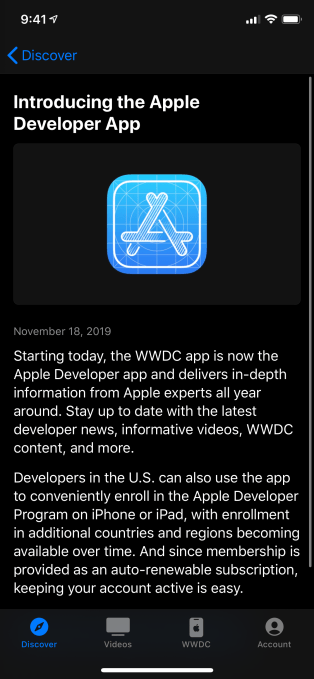
At launch, the Apple Developer app may not have everything you could otherwise find on AppleDeveloper website, but its offerings will grow over time. For example, today you&ll find technical information and more than 600 videos, but you won&t find things like the Apple Developer Forums or a way to connect a local Apple Developer program — like AppleApp Accelerators, Design Labs or Developer Academies.
Instead, the appcontent is organized across four main sections: Discover, for finding developer information, news and updates; Videos, where you&ll find the videos the WWDC app once hosted; WWDC, for event attendees; and Account, where developers can manage their account and program membership.
Applegoal is to use the app to get relevant content in front of developers in a timely fashion and to point them to things they may not even realize exist on the Apple Developer website, or even at Apple, overall. And in some cases, the app will include more mobile-friendly content — like articles that attempt to educate in a more digestible, short-form manner.
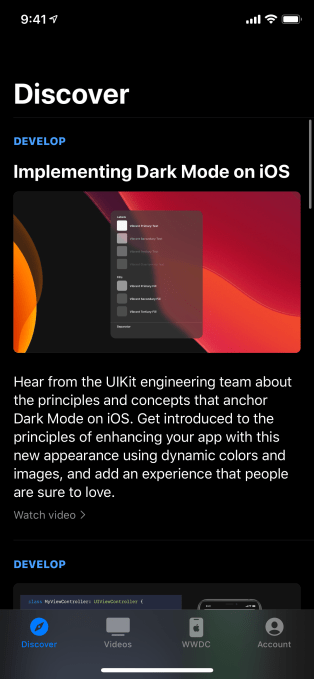
In other words, it may be the same content as found online in technical papers, but packaged in a slightly different way. Later, the app will also expand to address some of the things that Apple hasn&t yet documented — a topic of increasing concern among developers as of late. (One developer even built a website called &No Overview Available& that helps you find out if an Apple API is missing documentation.)
Elsewhere in the app, developers will continue to be able to watch WWDC session videos and review the WWDC schedule, when available. They&ll also be able to sign up for or renew an Apple Developer program membership, then pay for it using Apple Pay or other payment methods.
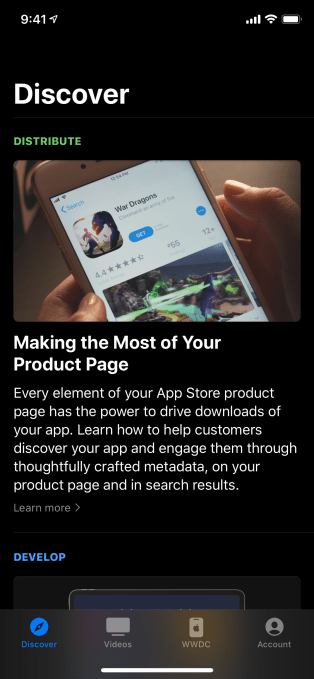
The applaunch comes at a time when Apple has been focused on growing its international community of developers through investments in local developer academies and accelerators — efforts that have been paying off.
For example, over the past year, the developer community in Indonesia grew its membership by 60% after the opening of two Developer Academy facilities in 2019. In Brazil, the original location for an Apple Developer Academy, the community grew by 50% this year. In India, the location of Applefirst accelerator lab, the community grew by 45%. Other areas that grew their developer base this year included the U.K. (up 40%), France (30%), Italy (28%) and China (17%).
[gallery ids="1913485,1913484,1913483,1913482,1913478,1913477,1913476,1913481,1913480,1913479,1913475,1913474,1913473,1913472"]
In serving these regions, Apple found that some developers are more inclined to open an app than they are an email — which is another reason it wanted to offer a mobile-optimized, mobile-friendly developer resource. Plus, the company discovered it had developer resources that some people didn&t even know about, like its App Store mini site. By centralizing all this content into an app, itmore accessible.
The Apple Developer app is being soft-launched today in all worldwide markets, but Apple Developer program membership management tools are U.S.-only for now. Apple considers this a version 1, and aims to get developer feedback as it expands.
The Apple Developer app is available on iOS, including Apple Watch and iMessage.
- Details
- Category: Technology
Read more: Apple launches a dedicated mobile app for its developer community
Write comment (99 Comments)A year and a half after getting acquired by Salesforce for $6.5 billion, MuleSoft is beginning to resemble a Salesforce company — using its language and its methodologies to describe new products and services. This week at Dreamforce, as the companymega customer conference begins in San Francisco, MuleSoft announced a slew of new services as it integrates more deeply into the Salesforce family of products.
MuleSoft creates APIs to connect different systems together. This could be quite useful for Salesforce as a bridge between older software that may be on-prem or in the cloud. It allows Salesforce and its customers to access data wherever it lives, even from different parts of the Salesforce ecosystem itself.
MuleSoft made a number of announcements designed to simplify that process and put it in the hands of more customers. For starters, itannouncing Accelerators, which are pre-defined integrations that let companies connect more easily to other systems. Not surprisingly, two of the first ones connect data from external products and services to Salesforce Service Cloud and Salesforce Commerce Cloud.
&What we&ve done is we&ve pre-built integrations to common back-end systems like ServiceNow and JIRA in Service Cloud, and we prebuilt those integrations, and then automatically connected that data and services through a Salesforce Lightning component directly in the Service console,& Lindsey Irvine, chief marketing officer at MuleSoft, explained.
What this does is allow the agent to get a more complete view of the customer by getting not just the data thatstored in Salesforce, but in other systems as well.
The company also wants to put these kinds of integration skills in the hands of more Salesforce customers, so they have designed a set of courses in Trailhead, the companytraining platform, with the goal of helping 100,000 Salesforce admins, developers, integration architects and line of business users develop expertise around creating and managing these kinds of integrations.
The company is also putting resources into creating the API Community Manager, a place where people involved in building and managing these integrations can get help from a community of users, all built on Salesforce products and services, says Mark Dao, chief product officer at MuleSoft.
&We&re leveraging Community Cloud, Service Cloud and Marketing Cloud to create a true developer experience platform. And whatinteresting is that ittargeting both the business users — in other words, business development teams and marketing teams — as well as external developers,& he said. He added that the fact this is working with business users as well as the integration experts is something new, and the goal is to drive increased usage of APIs using MuleSoft inside Salesforce customer organizations.
Finally, the company announced Flow Designer, a new tool fueled by Einstein AI, which helps automate the creation of workflows and integrations between systems in a more automated fashion without requiring coding skills.
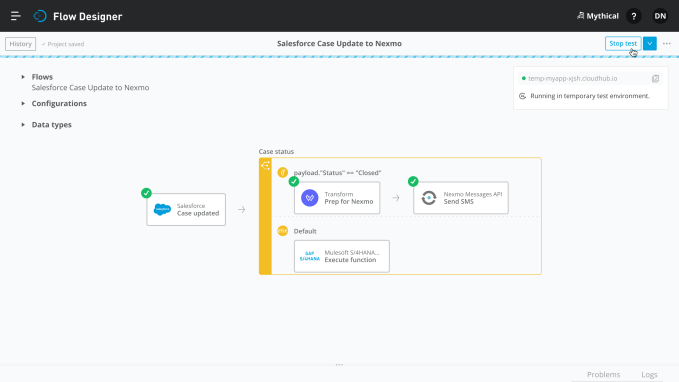
MuleSoft Flow Designer requires no coding (Screenshot: MuleSoft)
Dao says this is about putting MuleSoft in reach of more users. &Itabout enabling use cases for less technical users in the context of the MuleSoft Anypoint Platform. This really requires a new way of thinking around creating integrations, and we&ve been making Flow Designer simpler and simpler, and removing that technical layer from those users,& he said.
API Community Manager is available now. Accelerators will be available by the end of the year and Flow Designer updates will be available Q2 2020, according to the company.
These and other features are all designed to take some of the complexity out of using MuleSoft to help connect various systems across the organization, including both Salesforce and external programs, to make use of data wherever it lives. MuleSoft does requires a fair bit of technical skill, so if the company is able to simplify integration tasks, it could help put it in the hands of more users.
- Details
- Category: Technology
Read more: 18 months after acquisition, MuleSoft is integrating more deeply into Salesforce
Write comment (93 Comments)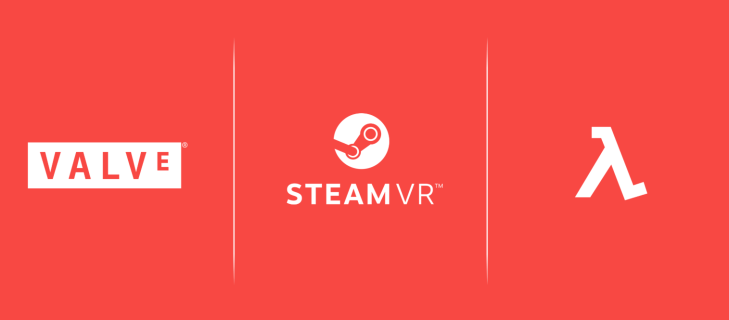
After what feels like years of rumors, itofficial: Valve is making a virtual reality Half-Life game.
Official word of the new title comes via Valve(brand new, but verified) Twitter account, where the company is promising more details later this week:
While ita bit curious to drop news like this as the first tweet from a brand new account, Valvelong-established official Steam twitter account retweeted it — so signs are pointing toward it being legit.
Alas, we know next to nothing besides the name — Half-Life: Alyx — until 10 am on Thursday. Will we finally get a proper conclusion for Alyx Vance, whose storyline ended so abruptly when Valve dropped the Half-Life storyline mid-sentence 12 years ago ?
- Details
- Category: Technology
Read more: Valve confirms it’s making a ‘flagship’ Half-Life VR game
Write comment (94 Comments)The world is being mapped in 3D — one brick, one bench, one building at a time. For things like hyper-accurate augmented reality, autonomous robots and self-driving cars, 2D maps and GPS only get you so far.
Apple is building its map with lasers strapped to the tops of cars. Niantic has talked about building 3D maps of parks and public spaces by way of user-submitted imagery. The Army is making 3D maps with drones.
Ubiquity6, a startup thatspent much of the last two years quietly chipping away at the challenges of building shared augmented reality experiences, is trying something different: a social network, of sorts, for scanning and sharing 3D spaces.
The companyfirst publicly launched app, Display.land, started rolling out on iOS and Android over the weekend. Part 3D scanner and part social network, it lets you scan a location or object, edit it (cropping it to just the bits you&re interested in, or adding pre-built digital objects), and share it with the world. Want everyone to see it? You can pin a scan to a map, allowing anyone panning by to explore your scan. Want to keep it to yourself? Flip the privacy toggle accordingly.
The idea: quick and simple 3D scans of real-world spaces, shareable at large or just with the people you choose. Exploring a new city and found some neat art in an alleyway? Scan it and post it for everyone to &walk& around. Renting an apartment and want to give potential tenants some idea of what the space is like? Scan it, put the link in the listing and it&ll open right up in their browser without any downloads.

Starting a new scan is simple: hit the &new& button, find some particularly interesting bit of geometry to focus on and hit &begin.& As you radiate away from the initial focal point, you&ll see your camera view filling with countless colored spheres. Each sphere represents a geometric feature that the camera has captured, helping to highlight the areas that have been sufficiently covered.
As you roam, a bar starts to stretch across the bottom of your screen. Once it seems like you&ve captured enough geometry for a complete mesh, the app will let you know — but if you want your scan to be more true to life, you&re free to continue scanning until the bar is completely full.
Between the point cloud data and all of the photographic textures being captured, these scans can get pretty big. My test scans were coming in at a few hundred megabytes. That&ll eat up your data quick if you&re uploading over a cell network, so you&ve got the option to hold off uploading until you&re back on Wi-Fi. Once uploaded, Ubiquity6 will take a few minutes to process everything, crunching all of the raw data into a model you can fly around and explore.
While the scans it makes are rarely perfect, it&s… really damned wild what they&re pulling off with just your phoneRGB camera and its assorted built-in sensors. With a bit of practice and sufficient lighting, the scans it can pull off are rather incredible. Check out this scan of Ron MueckMask II sculpture from the SF MOMA, for example — or this pool from a skatepark in SFMission District. (And note that itall rendering live in the browser; you can scroll to zoom, orbit around, etc.)

Scanning/editing/sharing is free. If you&re feeling fancy, you can even open your scan in a browser and download it in a file format (OBJ, PLY, or GLTF) thatready to be fiddled with in your desktop 3D modeling software of choice. As for how they&ll make money? The company plans to charge companies that need a bit more than the base offering — if a company wants to 3D scan a space at the highest possible fidelity, for example, they can pay extra for the added processing time.
Meanwhile, they&re laying the groundwork for what seems to be the companyactual interest: shared, multiplayer augmented reality experiences. For now, these scans are mostly static — you can add cutesy 3D models like treasure chests and floating butterflies to mix it up a bit, but they&re mostly there just to be pretty. In time, though, they&re looking to add gaming elements; think games that automatically unlock when you walk into a certain physical space, with physics and functionality determined by the real-world geometry around you.
Ubiquity6 has raised a little over $37 million to date. Itbacked by KPCB, First Round, Index Ventures, Benchmark and Gradient, and was part of Disneyfifth accelerator class.
- Details
- Category: Technology
Read more: Ubiquity6’s Display.land is part 3D scanner, part social network
Write comment (98 Comments)French startup Luko has raised a $22 million Series A round led by Accel (€20 million). Founders Fund and Speedinvest are also participating in todayfunding round.
When you rent a place in France, you have to provide a certificate to your landlord saying that you are covered with a home insurance product. And, of course, you might want to insure your place if you own it.
While the market is huge, legacy insurance companies still dominate it. Thatwhy Luko wants to shake things up in three different ways.
First, ithard to sign up to home insurance in France. It usually involves a lot of emails, a printer, some signatures, etc. It can quickly add up if you want to change your coverage level or add some options.
As expected, Lukosignup process is pretty straightforward. You fill out a form on the companywebsite and you get an insurance certificate minutes later.
Luko partners with La Parisienne Assurances to issue insurance contracts. So far, 15,000 people have signed up to Luko.
Second, if theresome water damage or a fire, it can take a lot of time to get it fixed. Worse, if somebody breaks into your place, you&re not going to get your money back that quickly.
Luko wants to speed things up. You can make a claim via chat, over the phone or with a video call using the mobile app. The company tries its best to detect fraud and pay a claim as quickly as possible. Luko also recently announced an integration with Lydia, a popular peer-to-peer payment app in France, so that your payment is instant.
Third, Luko has a bold vision to make home insurance even more effective. The startup wants to detect issues before ittoo late. For instance, you could imagine receiving a water meter from Luko to detect leaks, or a door sensor to detect when somebody is trying to get in. We&ll find out if people actually want to put connected objects everywhere.
Finally, Luko has partnered with a handful of nonprofits to redistribute some of its revenue — it has received the BCorp certification. The startup makes revenue by taking a flat fee on your monthly subscription. If theremoney left at the end of the year, Luko donates it to charities. Investors signed a pledge so that Luko doesn&t trade this model for growth.
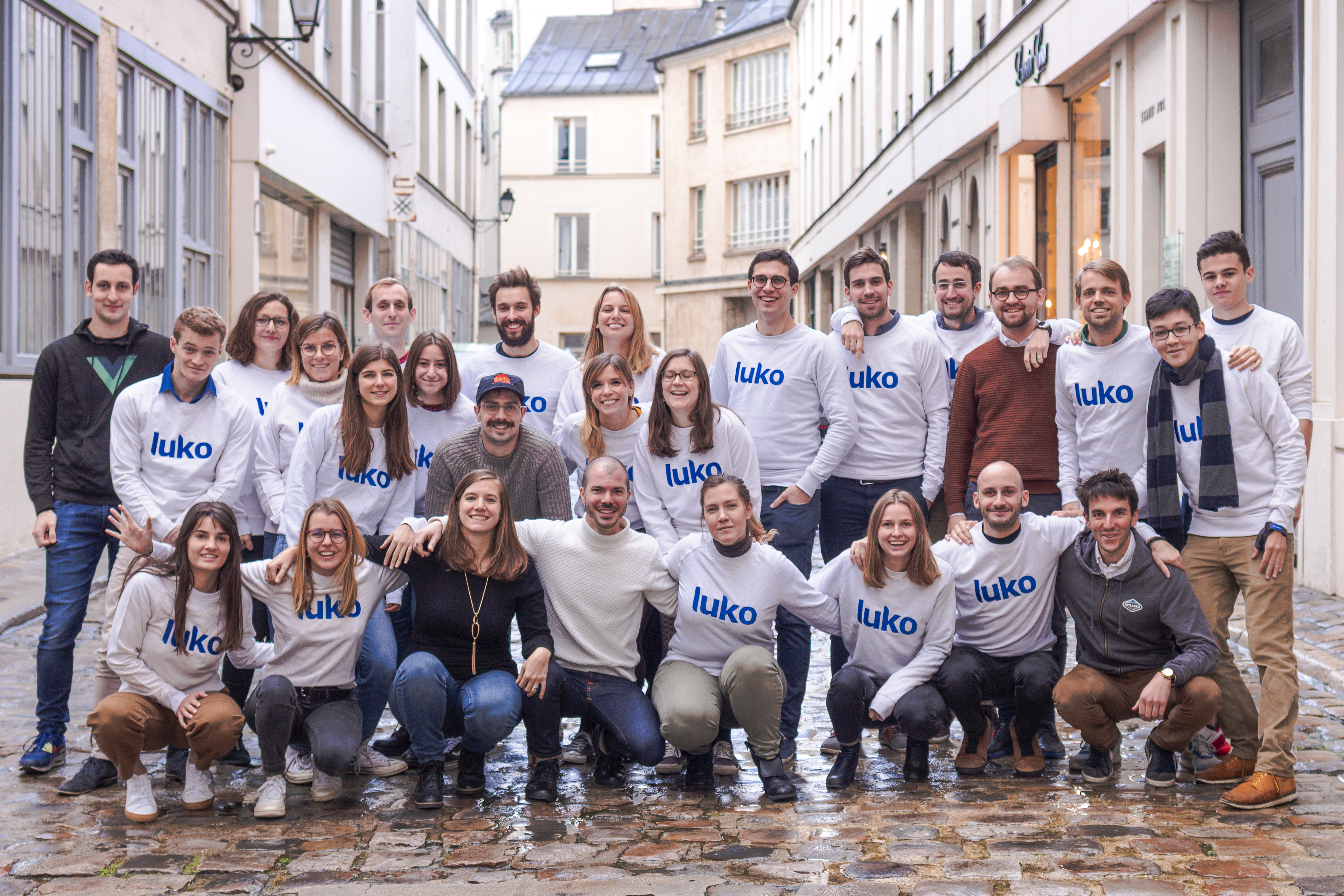
- Details
- Category: Technology
Read more: Luko raises $22 million to improve home insurance
Write comment (94 Comments)Page 323 of 5614

 10
10